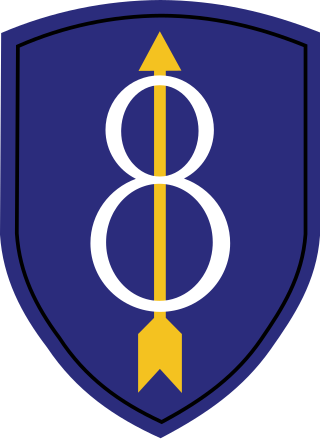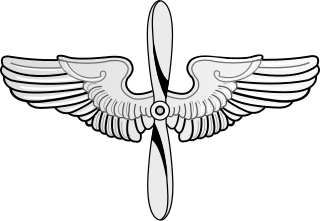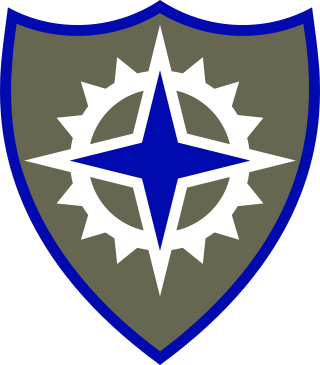Related Research Articles
A Corps area was a geographically-based organizational structure of the United States Army used to accomplish administrative, training and tactical tasks from 1920 to 1942. Each corps area included divisions of the Regular Army, Organized Reserve and National Guard of the United States. Developed as a result of serious mobilization problems during World War I, this organization provided a framework to rapidly expand the Army in time of war or national emergency such as the Great Depression.

V Corps, formerly known as the Fifth Corps, is a regular corps of the United States Army at Fort Knox. It was previously active during World War I, World War II, the Cold War, the Kosovo War, and the War on Terrorism.

The VI Corps was activated as VI Army Corps in August 1918 at Neufchâteau, France, serving in the Lorraine Campaign. Constituted in the Organized Reserves in 1921, it was allotted to the Regular Army in 1933 and activated on 1 August 1940 at Fort Sheridan, Illinois. VI Corps took part in some of the most high-profile operations in World War II.

The 78th Training Division (Operations) ("Lightning") is a unit of the United States Army which served in World War I and World War II as the 78th Infantry Division, and currently trains and evaluates units of the United States Army Reserve for deployment.

The 84th Training Command ("Railsplitters") is a formation of the United States Army. During World War I it was designated the 84th Division, American Expeditionary Forces; during World War II it was known as the 84th Infantry Division. From 1946 to 1952, the division was a part of the United States Army Reserve as the 84th Airborne Division. In 1959, the division was reorganized and redesignated once more as the 84th Division. The division was headquartered in Milwaukee in command of over 4,100 soldiers divided into eight brigades—including an ROTC brigade—spread throughout seven states.

The 8th Infantry Division, ("Pathfinder") was an infantry division of the United States Army during the 20th century. The division served in World War I, World War II, and Operation Desert Storm. Initially activated in January 1918, the unit did not see combat during World War I and returned to the United States. Some units would serve in the American Expeditionary Force to Siberia. Activated again on 1 July 1940 as part of the build-up of military forces prior to the United States' entry into World War II, the division saw extensive action in the European Theatre of Operations. Following World War II, the division was moved to West Germany, where it remained stationed at the Rose Barracks in Bad Kreuznach until it was inactivated on 17 January 1992.

The 103rd Infantry Division was a unit of the United States Army that served in the U.S. Seventh Army of the 6th Army Group during World War II.

The 79th Infantry Division was an infantry formation of the United States Army Reserve in World Wars I and II.

The 88th Infantry Division was an infantry division of the United States Army that saw service in both World War I and World War II. It was one of the first of the Organized Reserve divisions to be called into federal service, created nearly "from scratch" after the implementation of the draft in 1940. Previous divisions were composed of either Regular Army or National Guard personnel. Much of the experience in reactivating it was used in the subsequent expansion of the U.S. Army.

The 81st Readiness Division ("Wildcat") was a formation of the United States Army originally organized as the '81st Infantry Division' during World War I. After World War I, the 81st Division was allotted to the Organized Reserve as a "skeletonized" cadre division. In 1942, the division was reactivated and reorganized as the 81st Infantry Division, and served in the Pacific during World War II. After World War II, the 81st Infantry Division was allotted to the Organized Reserve as a Class C cadre division, and stationed at Atlanta, Georgia. The 81st Infantry Division saw no active service during the Cold War, and was inactivated in 1965.

The 86th Infantry Division, also known as the Blackhawk Division, was a unit of the United States Army in World War I and World War II. Currently called the 86th Training Division, based at Fort McCoy, Wisconsin, members of the division now work with Active Army, Reserve, and National Guard units to provide them with a Decisive Action Training Environment on a yearly basis.

The 76th Infantry Division was a unit of the United States Army in World War I, World War II and the Cold War. The division was inactivated in 1996 and has been reconstituted as the 76th US Army Reserve Operational Response Command in 2013.

The XXI Corps was an Army Corps of the British Army during World War I. The Corps was formed in Palestine in August 1917 under the command of Lieutenant General Edward Bulfin. It formed part of the Egyptian Expeditionary Force (EEF) and served in the Sinai and Palestine Campaign. At the Battle of Sharon it fought what has been described as 'one of the most overwhelmingly successful operations of the war' and 'a precursor to the modern Blitzkrieg.' It then carried out remarkable march up the coast of modern-day Lebanon as the war came to an end.

The United States Army Air Corps (USAAC) was the aerial warfare service component of the United States Army between 1926 and 1941. After World War I, as early aviation became an increasingly important part of modern warfare, a philosophical rift developed between more traditional ground-based army personnel and those who felt that aircraft were being underutilized and that air operations were being stifled for political reasons unrelated to their effectiveness. The USAAC was renamed from the earlier United States Army Air Service on 2 July 1926, and was part of the larger United States Army. The Air Corps became the United States Army Air Forces (USAAF) on 20 June 1941, giving it greater autonomy from the Army's middle-level command structure. During World War II, although not an administrative echelon, the Air Corps (AC) remained as one of the combat arms of the Army until 1947, when it was legally abolished by legislation establishing the Department of the Air Force.

The Eastern Command of the Pakistan Army was a corps-sized military formation headed by a lieutenant-general, who was designated the Eastern Command Commander. After the partition of India by United Kingdom, the Islamic Republic of Pakistan was divided into two territories separated by 1,000 miles (1,600 km). Most of the assets of the Pakistan armed forces were stationed in West Pakistan; the role of the Pakistan armed forces in East Pakistan was to hold that part of the country until the Pakistani forces defeated India in the west. The Pakistan Army created the Eastern Command, with one commander in the rank of Lieutenant General responsible for the command. The armed forces, had drawn up a plan to defend Dhaka by concentrating all their forces along the Dhaka Bowl.

The XVI Corps was a corps-sized formation of the United States Army.

Far East Command (FECOM) was a unified combatant command of the United States Department of Defense, active from 1947 until 1957, functionally organised to undertake the occupation of Japan and Korea. The 1st and 6th Marine Divisions, who from 1945 to 1948 assisted the Chinese government in occupying northern China, disarming the Japanese, and helping the Kuomintang Chinese without fully getting involved in the Chinese Civil War, were not part of Far East Command and reported to Pacific Command and the U.S. Navy.
The First Corps Area was a Corps area of the United States Army 1921-1942.
The Seventh Corps Area was a Corps area, effectively a military district, of the United States Army active from 1920 to 1941. It initially was responsible for army forces in Kansas, Minnesota, Missouri, North Dakota, South Dakota, Iowa and Nebraska. Army responsibility for Arkansas was transferred from the Fourth Corps Area to the Seventh Corps Area on 1 December 1920. In October 1940, the War Department implemented a transfer of tactical command functions of the Corps areas, moving tactical forces to field armies and transforming the Corps areas to Service Commands, themselves part of Army Service Forces. The Seventh Corps Area maintained its name until May 1941, when it was officially designated HQ, Seventh Corps Area Service Command in May 1941. While the Seventh Corps Area no longer existed, the HQ, Seventh CASC – later re-designated HQ, Seventh Service Command – continued until January 1944.
Sixth Corps Area was a Corps area, effectively a military district, of the United States Army from 1921 to the 1940s. The headquarters was established at Fort Sheridan, Illinois, in August 1920, from portions of the former Central Department, but then moved to the U.S. Post Office Building at 1819 West Pershing Road in Chicago on 10 October 1921.
References
- ↑ "United States Army Air Service Posts," U.S. Army Recruiting News, A Bulletin of Recruiting Information Issued by the Direction of the Adjutant General of the Army, February 15, 1925
- ↑ Clay 2010c , pp. by unit entries
- ↑ Clay 2010a, p. 48.
- ↑ Clay 2010a, p. 154.
- 1 2 Clay 2010, Volume I, p.48.
- Clay, Lt. Col. Steven E. (2010a). US Army Order of Battle 1919-1941 Volume 1. The Arms: Major Commands and Infantry Organizations. Command and General Staff College, Kansas: Combat Studies Institute Press.
- Clay, Lt. Col. Steven E. (2010c). US Army Order of Battle 1919-1941 Vol. 3: The Services: Air Service, Engineers, and Special Troops Organizations (PDF). Command and General Staff College, Kansas: Combat Studies Institute Press. ISBN 978-0-9841901-4-0. Archived from the original (PDF) on 2011-08-13. Retrieved 2011-09-20.